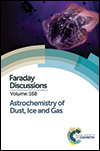Stability of carbonaceous dust analogues and glycine under UV irradiation and electron bombardment
Abstract
The effect of UV photon (120–200 nm) and electron (2 keV) irradiation of analogues of interstellar carbonaceous dust and of glycine were investigated by means of IR spectroscopy. Films of hydrogenated amorphous carbon (HAC), taken as dust analogues, were found to be stable under UV photon and electron bombardment. High fluences of photons and electrons, of the order of 1019 cm−2, were needed for a film depletion of a few percent. UV photons were energetically more effective than electrons for depletion and led to a certain dehydrogenation of the HAC samples, whereas electrons led seemingly to a gradual erosion with no appreciable changes in the hydrocarbon structure. The rates of change observed may be relevant over the lifetime of a diffuse cloud, but cannot account for the rapid changes in hydrocarbon IR bands during the evolution of some proto-planetary nebulae. Glycine samples under the same photon and electron fluxes decay at a much faster rate, but tend usually to an equilibrium value different from zero, especially at low temperatures. Reversible reactions re-forming glycine, or the build-up of less transparent products, could explain this behavior. CO2 and methylamine were identified as UV photoproducts. Electron irradiation led to a gradual disappearance of the glycine layers, also with formation of CO2. No other reaction products were clearly identified. The thicker glycine layers (a few hundred nm) were not wholly depleted, but a film of the order of the electron penetration depth (80 nm), was totally destroyed with an electron fluence of ∼1 × 1018 cm−2. A 60 nm ice layer on top of glycine provided only partial shielding from the 2 keV electrons. From an energetic point of view, 2 keV electrons are less efficient than UV photons and, according to literature data, much less efficient than MeV protons for the destruction of glycine. The use of keV electrons to simulate effects of cosmic rays on analogues of interstellar grains should be taken with care, due to the low penetration depths of electrons in many samples of interest.
- This article is part of the themed collection: Astrochemistry of Dust, Ice and Gas

 Please wait while we load your content...
Please wait while we load your content...